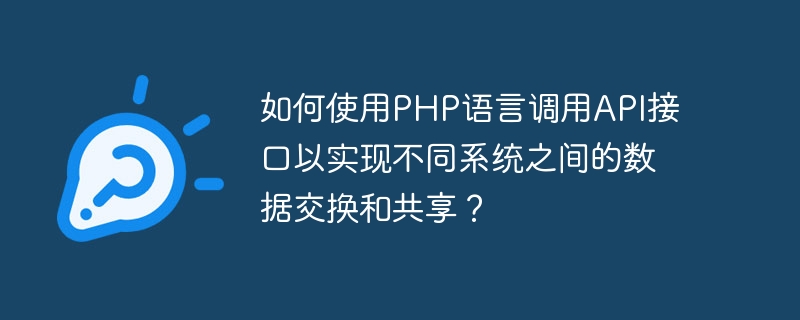

How to use PHP language to call API interface to realize data exchange and sharing between different systems?
With the development of the Internet, data exchange and sharing between different systems has become more and more common. In order to realize data interaction between different systems, a common method is to use API (Application Programming Interface) interface. API is an interface that defines interaction rules between different software components. Data exchange and sharing between different systems can be achieved through API.
In web development, the PHP language is widely used to interact with API interfaces. The following will introduce how to use PHP language to call API interfaces to achieve data interaction and sharing between different systems.
First of all, we need to understand the basic concepts and usage process of API interfaces. API interfaces usually use HTTP protocol for communication. Common API interface formats include RESTful API and SOAP API. Simply put, using the API interface is to send an HTTP request to the API server and obtain the data returned by the server.
Next, we use a simple example to demonstrate how to use PHP language to call the API interface. Suppose we need to call a weather API interface to obtain weather data for a certain city.
First, we need to provide the address and parameters of the API interface. Taking Beijing weather data as an example, the API interface address is: http://api.weather.com/weather?city=beijing. Among them, city is a parameter, indicating the city that needs to be obtained.
Next, we use PHP’s curl library to send HTTP requests and get the data returned by the interface. The sample code is as follows:
// 创建一个curl句柄 $ch = curl_init(); // 设置请求的URL地址 $url = 'http://api.weather.com/weather?city=beijing'; curl_setopt($ch, CURLOPT_URL, $url); // 设置curl的参数 curl_setopt($ch, CURLOPT_RETURNTRANSFER, 1); // 发送请求并获取服务器返回的数据 $response = curl_exec($ch); // 关闭curl句柄 curl_close($ch); // 处理返回的数据 $data = json_decode($response, true); // 将返回的JSON格式数据转换为PHP数组 echo '当前城市:' . $data['city'] . '<br>'; echo '当前温度:' . $data['temperature'] . '℃<br>'; echo '当前天气:' . $data['weather'] . '<br>';
In the above code, we first use the curl_init() function to create a curl handle, and then use the curl_setopt() function to set the requested URL address and other parameters, including the format of the returned data, etc. Next, use the curl_exec() function to send an HTTP request and obtain the data returned by the server. Finally, use the json_decode() function to convert the returned JSON format data into a PHP array and print out the relevant weather information.
Through the above example, we can see that it is very simple to call the API interface using PHP. Just prepare the address and parameters of the API interface and use the curl library to send the request. After obtaining the data returned by the server, we can further process and display it as needed.
To summarize, data exchange and sharing between different systems can be achieved by calling the API interface through PHP. By properly setting request parameters and processing the returned data, we can use API interfaces to obtain various data provided by other systems and realize data interaction and sharing. Through continuous learning and practice, we can become more proficient in using PHP to call API interfaces and play its huge role in practical applications.
The above is the detailed content of How to use PHP language to call API interface to realize data exchange and sharing between different systems?. For more information, please follow other related articles on the PHP Chinese website!




